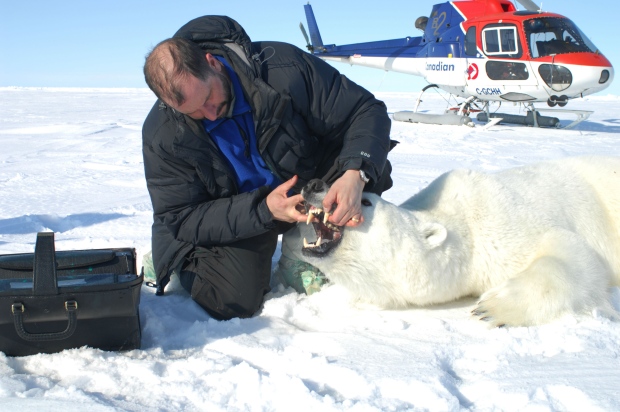The U.S. study, published in the Royal Society's Biology Letters, found a 71 per cent chance that the mean global population size will decline by more than one-third over the next 34-41 years, a period the authors describe as "three polar bear generations."
Less sea ice, fewer bears
The numbers are based on mathematical models the researchers used to predict the effect climate change will have on sea ice in the future.
Since 1979, sea ice melted an average of 1.26 days earlier across the the four polar bear ecoregions and 19 subpopulation areas.
According to the study authors, that rate of ice melt will result in a 71 per cent likelihood that the polar bear population will decrease to less than 18,000, from 26,000.
The study said those findings would be consistent with listing the species as "vulnerable" according to the International Union for Conservation of Nature (IUCN) Red List of Threatened Species.
While the likelihood of a more than 30 per cent loss was high, the study found little chance of populations reaching near-extinction levels.
'Overly optimistic,' says researcher
"The one problem I've got is that it's probably overly optimistic," says University of Alberta bear biologist Andrew Derocher of the study, while adding that the numbers are consistent with past research.
"If we look at 2016 for sea ice, it was a lot worse than anything else we've seen in the record.
"Even the sea ice we've seen for November, this past month, the results are dramatically different than the longer term projections… I think the actual conditions for polar bears may be worse than this paper puts forward.
"We've done a fair bit of work to indicate that just one or two bad years in an area can have devastating effects on a population," he says.
'A simplistic approach'
While Derocher credits the paper's rigour, he is cautious to point out that a global assessment doesn't necessarily capture the whole picture.
"If we did look at some of these areas on a population by population basis they would certainly qualify for an endangered [rather than vulnerable] status, which is the next tier up in the level of concern, but because we sort of say we're looking at polar bears collectively across the whole Arctic, some populations are doing just fine."
Derocher says the concern for some of the subpopulations is reaching a critical juncture, particularly within some parts of Canada.
"Research we've done with the Hudson's Bay population suggests very clearly that we likely will not have polar bears in that area by mid-century… It's also very unlikely bears with persist in the southern Beaufort past that time."
While Derocher says that relying on mathematical models to predict future polar bear populations is "not a bad approach," he adds that "it's a very simplified approach," and points to some important next steps.
"I think the challenge going forward is that a lot of these populations we don't have good monitoring information on.
"For example, one of the areas where we think polar bears will persist for the longest, up in Norwegian Bay in the high Canadian Arctic, nobody has looked there to see what's going on for many, many years now."
Derocher also wants researchers to look more closely at "management procedures."
"It's clear that we understand the fundaments of what's going on in respect to habitat loss in… but how do we try and reduce problems with human-bear interactions?
"A lot of these northern communities aren't prepared to deal with polar bears coming around town… but going forward in time we expect that to be more common."
©CBC News Canada


